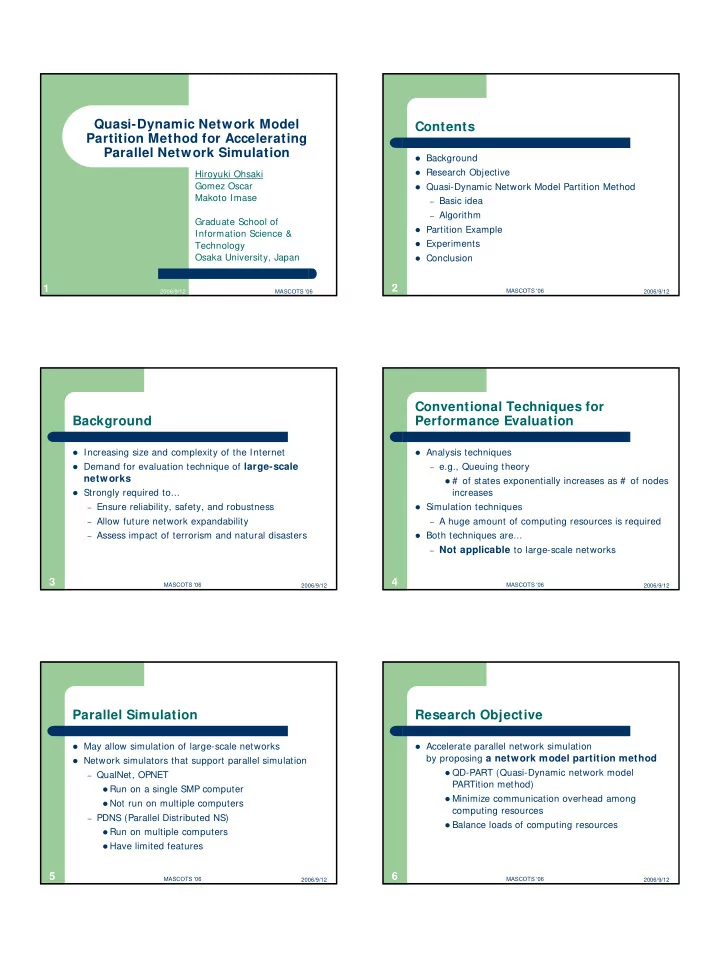

Quasi-Dynamic Network Model Contents Partition Method for Accelerating Parallel Network Simulation � Background � Research Objective Hiroyuki Ohsaki Gomez Oscar � Quasi-Dynamic Network Model Partition Method Makoto Imase – Basic idea – Algorithm Graduate School of � Partition Example Information Science & � Experiments Technology Osaka University, Japan � Conclusion 1 2 MASCOTS '06 2006/9/12 MASCOTS '06 2006/9/12 Conventional Techniques for Background Performance Evaluation � Increasing size and complexity of the Internet � Analysis techniques � Demand for evaluation technique of large-scale – e.g., Queuing theory networks � # of states exponentially increases as # of nodes � Strongly required to... increases – Ensure reliability, safety, and robustness � Simulation techniques – Allow future network expandability – A huge amount of computing resources is required – Assess impact of terrorism and natural disasters � Both techniques are... – Not applicable to large-scale networks 3 4 MASCOTS '06 2006/9/12 MASCOTS '06 2006/9/12 Parallel Simulation Research Objective � May allow simulation of large-scale networks � Accelerate parallel network simulation by proposing a network model partition method � Network simulators that support parallel simulation � QD-PART (Quasi-Dynamic network model – QualNet, OPNET PARTition method) � Run on a single SMP computer � Minimize communication overhead among � Not run on multiple computers computing resources – PDNS (Parallel Distributed NS) � Balance loads of computing resources � Run on multiple computers � Have limited features 5 6 MASCOTS '06 2006/9/12 MASCOTS '06 2006/9/12
Network Model Partition Overview Basic I dea of QD-PART � In many network simulation studies... – A network simulation is typically repeated several times with the same parameter set ... for estimating the confidence interval of steady state measures – Partition of a network model can be gradually optimized based on past simulation results � Total simulation time � CPU usage of computing resources � Traffic intensity (i.e., # of packets transmitted) 7 8 MASCOTS '06 MASCOTS '06 2006/9/12 2006/9/12 QD-PART Algorithm: Notation QD-PART Algorithm: Step 1 � Network model � 1. Make initial partition – G = (V,E) – Assume all links have the same traffic intensity control parameter – V: node (host, router) – E: link propagation delay – w(i,j): edge weight – Apply a graph partition algorithm METIS [7] � Results in N sub-graphs G1...GN – Perform parallel simulation and measure statistics � 2. Make second partition based on traffic intensity � 3. Improve partition using measured CPU usage 9 10 MASCOTS '06 2006/9/12 MASCOTS '06 2006/9/12 QD-PART Algorithm: Step 2 QD-PART Algorithm: Step 3 � 1. Make initial partition � 1. Make initial partition � 2. Make second partition based on traffic intensity � 2. Make second partition based on traffic intensity – Take account of the measured traffic intensity � 3. Improve partition using measured CPU usage traffic intensity – Move boundary nodes... (e.g., # of packets from the most loaded computing resource transmitted) – Apply a graph partition algorithm METIS [7] to the least loaded computing resource � Results in N sub-graphs G1...GN – Perform parallel simulation and measure statistics – Perform parallel simulation and measure statistics – If the total simulation time is reduced... � 3. Improve partition using measured CPU usage � Repeat step 3 11 12 MASCOTS '06 2006/9/12 MASCOTS '06 2006/9/12
Nodes in G1 Nodes in G1 Partition example: a network measured traffic (20 nodes, 5 flows) intensity Partition Example into two sub-network (i.e., # of packets models transmitted) TCP flow TCP flow Nodes in G2 Nodes in G2 crossing link crossing link Step 1: make initial partition Step 2: make second partition by assuming all links have the based on the measured same traffic intensity traffic intensity 13 14 MASCOTS '06 MASCOTS '06 2006/9/12 2006/9/12 Nodes in G1 computing resource Experiment Setup for G2 was more loaded! TCP flow � 2 computing resources (partition into two sub-network models) – Intel Xeon 2.4GHz with 1,024MB memory – Linux 2.4.30 – PDNS version 2.27-v1a Nodes in G2 – 1G Ethernet crossing link Step 3: improve partition using measured CPU usage ; move nodes from G2 to G1 15 16 MASCOTS '06 2006/9/12 MASCOTS '06 2006/9/12 Total Simulation Time vs. # of Simulation Model Simulation Run (Homogeneous Case) � Network model homogeneous case – Number of nodes: 20 – Number of links: 20 – Link bandwidth: 1 or 0-1 [Mbit/s] – Link propagation delay: 1 or 0-1 [ms] � Workload heterogeneous case – # of persistent TCP flows: 2 or 10 total simulation time is gradually reduced 17 18 MASCOTS '06 2006/9/12 MASCOTS '06 2006/9/12
Total Simulation Time vs. # of Simulation Run (Heterogeneous Case) Conclusion � Proposed a network model partition method QD-PART – To accelerate parallel network simulation � QD-PART... – Utilizes the fact that a network simulation is typically repeated several times – Re-partitions the network model based on past simulation results QD-PART is quite effective – Significantly reduces the total simulation time in heterogeneous case 19 20 MASCOTS '06 MASCOTS '06 2006/9/12 2006/9/12 Future Works � Through performance evaluation of QD-PART – Other types of network models – More computing resources � Extend QD-PART to support Grid environment – Heterogeneous computing resources – Heterogeneous networking resources 21 MASCOTS '06 2006/9/12
Recommend
More recommend